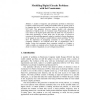Free Online Productivity Tools
i2Speak
i2Symbol
i2OCR
iTex2Img
iWeb2Print
iWeb2Shot
i2Type
iPdf2Split
iPdf2Merge
i2Bopomofo
i2Arabic
i2Style
i2Image
i2PDF
iLatex2Rtf
Sci2ools
CL
2000
Springer
2000
Springer
Modelling Digital Circuits Problems with Set Constraints
A number of diagnostic and optimisation problems in Electronics Computer Aided Design have usually been handled either by specific tools or by mapping them into a general problem solver (e.g. a propositional Boolean SAT tool). This approach, however, requires models with substantial duplication of digital circuits. In Constraint Logic Programming, the use of extra values in the digital signals (other than the usual 0/1) was proposed to reflect their dependency on some faulty gate. In this paper we present an extension of this modelling approach, using set variables to denote dependency of the signals on sets of faults, to model different circuits problems. We then show the importance of propagating constraints on sets cardinality, by comparing Cardinal, a set constraint solver that we implemented, with a simpler version that propagates these constraints similarly to Conjunto, a widely available set constraint solver. Results show speed ups of Cardinal of about two orders of magnitude, ...
Automated Reasoning | CL 2000 | General Problem Solver | Propositional Boolean Sat | Set Constraint Solver |
| Added | 02 Aug 2010 |
| Updated | 02 Aug 2010 |
| Type | Conference |
| Year | 2000 |
| Where | CL |
| Authors | Francisco Azevedo, Pedro Barahona |
Comments (0)

